A History of the County of Buckingham: Volume 3. Originally published by Victoria County History, London, 1925.
This free content was digitised by double rekeying. All rights reserved.
'Parishes: Linslade', in A History of the County of Buckingham: Volume 3, ed. William Page( London, 1925), British History Online https://prod.british-history.ac.uk/vch/bucks/vol3/pp387-391 [accessed 15 January 2025].
'Parishes: Linslade', in A History of the County of Buckingham: Volume 3. Edited by William Page( London, 1925), British History Online, accessed January 15, 2025, https://prod.british-history.ac.uk/vch/bucks/vol3/pp387-391.
"Parishes: Linslade". A History of the County of Buckingham: Volume 3. Ed. William Page(London, 1925), , British History Online. Web. 15 January 2025. https://prod.british-history.ac.uk/vch/bucks/vol3/pp387-391.
In this section
LINSLADE
Lincelada (xi cent.); Lichelade, Lynchelad-e (xii– xvii cent.); Lincelade (xiii–xvi cent.); Lyneslade, Linslade (xvi–xvii cent.).
Linslade has an extent of 1,693 acres, 170 of these being arable land, 629 permanent grass and 18 woods and plantations. (fn. 1) The land is undulating, the highest ground, about 430 ft. to 450 ft. above the ordnance datum, being in the west and south-west. In the north and in the extreme east the land is much lower, being roughly 260 ft. to 290 ft. The soil is principally sand; the subsoil sandstone and gravel. The chief crops are wheat, oats, and barley. The parish is well watered, and is bounded on the east by the Ouzel River, the Grand Junction Canal passing through the entire length of the parish, parallel with and quite close to the river. The London and North Western railway also passes through, the station of Leighton Buzzard being in this parish. The rapidly growing village of Linslade, formerly called New Linslade or Chelsea to distinguish it from the old village further north, occupies a large area in the east of the parish, and is separated by the river from the town of Leighton Buzzard. The church of St. Barnabas is in the centre, and there are also Baptist and Primitive Methodist chapels, built in 1843 and 1861 respectively. The hamlet of Southcott, consisting mainly of a few farms, residential houses and a mill, joins the village on the southwest. In the north lies the village of Old Linslade, which now comprises only the old church of St. Mary, still occasionally used, the manor-house, Linslade Hall, and one or two other buildings. The importance of the old village belongs to the last half of the 13th century, when Linslade became a market town and had a yearly eight-day fair (vide infra), these grants being possibly due to the fact that the Holy Well of Linslade attracted many pilgrims to the place. In 1299, however, the Bishop of Lincoln, stating that many persons made pilgrimages to this well, where miracles were pretended to be worked and offerings were made, commanded the Archdeacon of Buckingham to warn the pilgrims against the practice under the pain of excommunication and to cite the vicar of Linslade, who encouraged the error on account of the offerings, to appear before the bishop. (fn. 2) This prohibition may have affected the prosperity of the town, and no later accounts of either fair or market appear. The site of the well is just north of the old village.
In 1854, according to Sheahan, some three or four sepulchral urns were discovered in a gravel-pit. (fn. 3)
The parish is governed by an Urban District Council of nine members, which was formed 1 October 1897. No Inclosure Act has been passed.
MANORS
Before 975 Queen Aelfgyfu, by will, bequeathed to her lord her land at 'Hlincgeladae,' (fn. 4) which is probably an early form of LINSLADE, as other land mentioned in the bequest can be identified with the names of surrounding places.
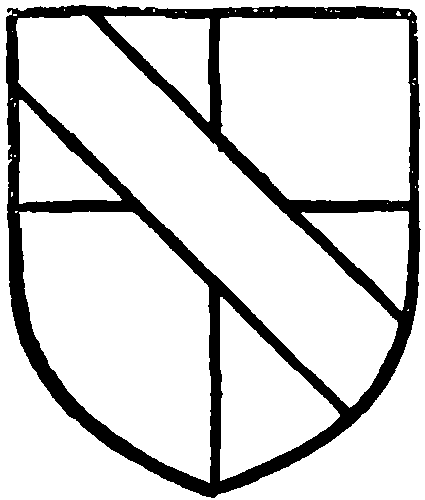
Beauchamp of Bedford. Quarterly or and gules a bend sable.
Alwin, a man of Queen Edith, held the manor of Linslade before the Conquest. (fn. 5) In 1086, assessed at 15 hides, it was held by Hugh de Beauchamp, (fn. 6) a Bedfordshire baron. Simon de Beauchamp, probably the great-grandson of Hugh, (fn. 7) made grants of property here in the latter part of the 12th century. (fn. 8) William son of Simon (fn. 9) was afterwards in possession. (fn. 10) He granted half the manor to Nichole Benet, (fn. 11) but the whole was in the possession of William de Beauchamp the younger before 1251, (fn. 12) although his father, the elder William, did not die until 1260. (fn. 13) After the death of William the son in 1262 (fn. 14) an inquiry was held to ascertain whether Nichole Benet had demised her moiety to the Prior of Newnham for her life, and the prior had then demised it for three years to William de Beauchamp, jun., and whether Nichole and the prior had surrendered it to him so that he died seised of it in fee. (fn. 15) The latter was evidently the case. John de Beauchamp, brother and heir of William, held Linslade at his death, which occurred on the field of Evesham. (fn. 16) Their three sisters and co-heirs inherited the lands of the barony of Bedford; the major part of Linslade fell to the share of the eldest sister Maud, (fn. 17) and may be regarded as afterwards forming the main manor, although the descendants of the other sisters Beatrice and Ela continued to hold land here for some time (vide infra).
At the time of her brother's death Maud was married to Roger de Mowbray, but he died about 1266, (fn. 18) and their son Roger was still a minor in 1278. (fn. 19) Roger L'Estraunge, second husband of Maud, held his wife's portion of Linslade in 1284–6 and until his death in 1311, (fn. 20) when, Maud being dead, John de Mowbray, son of Roger and grandson of Maud, succeeded. (fn. 21) He made a life grant of the manor to William de Braose in 1316. (fn. 22) John was hanged in 1322 after the battle of Boroughbridge. John de Mowbray, his son, was restored to his father's lands in 1327, (fn. 23) and in 1344 made a life grant of Linslade to John de Leybourne. (fn. 24) Shortly before his death, however, in 1361, (fn. 25) John de Mowbray settled the manor on himself and his wife Elizabeth for life, with remainder to John his son and heir. (fn. 26) His widow Elizabeth afterwards married Sir William de Cosynton, kt., and held Linslade in dower for life. (fn. 27) His son John de Mowbray married Elizabeth daughter and heir of John de Segrave and Margaret suo jure Countess of Norfolk, and died in 1368. (fn. 28) His son, the next John de Mowbray, a minor, entered into the estate on his grandmother's death in 1376. (fn. 29) He was created Earl of Nottingham in 1377 and died in 1382, his heir being his brother Thomas. (fn. 30) The latter was created Duke of Norfolk in 1397, on the same day on which his maternal grandmother was created Duchess of Norfolk. In 1400 he became, at her death, Earl of Norfolk. (fn. 31) He died in the same year, (fn. 32) having in 1392 granted Linslade to Robert, Bishop of London, and others in settlement on his son's marriage. (fn. 33) His widow Elizabeth was assigned the manor in dower and afterwards married Sir Robert Goushill, kt. (fn. 34) Thomas the son died in 1405, (fn. 35) and after the death of his widow Constance in 1437 Linslade passed to his nephew John fifth Duke of Norfolk, (fn. 36) who died in 1461. (fn. 37) His son John, sixth duke, held in 1469, (fn. 38) but died without male heirs in January, 1475–6. (fn. 39)
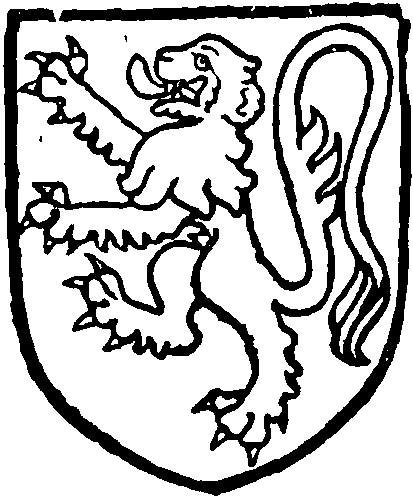
Mowbray. Gules a lion argent.
From the early part of the 15th century, however, the Mowbrays appear to have transferred the manorial rights and to have retained only the overlordship dues, which were vested in their descendant, Thomas Earl of Arundel, as late as 1637. (fn. 40)
Walter Lucy, kt., who is mentioned as their tenant in the manor in 1433, (fn. 41) was a member of a family which had held land in Linslade of the Beauchamps and the Mowbrays as far back as the 13th century. (fn. 42) From the 15th century until 1590 the manor descended with that of Cublington (q.v.), but was not alienated in 1590, being retained by Richard Corbet, who in 1606 (fn. 43) settled it on himself and his wife Judith for life, with remainder to the heirs male of his grandfather Sir Roger. Sir Richard died in 1608, (fn. 44) leaving as heir his brother Vincent, to whom his niece Elizabeth, wife of Sir Henry Wallopp, kt., quitclaimed her right in the same year. (fn. 45) Sir Andrew Corbet succeeded his father Sir Vincent in 1624, (fn. 46) but died in 1637, leaving a son Vincent, (fn. 47) who entered into possession of Linslade on the death of his great-aunt Judith about 1642. (fn. 48) He was created a baronet in the same year. (fn. 49) In 1646 he compounded for his estates as a Royalist, and a fine of £2,822 was levied on him, but this amount was afterwards reduced. (fn. 50) He died in 1656, and in 1679, on account of the services he had rendered to the cause of the late king, his widow was made a peeress for life under the title of Viscountess Corbet of Linslade. (fn. 51) Sir Vincent, their son, the second baronet, died in 1680, and in 1688, at the death of his son Vincent, the baronetcy became extinct. (fn. 52) The third baronet's heir was his sister Beatrice, wife of John Kynaston, (fn. 53) and she held part of Linslade in 1690. (fn. 54) At the same time Richard Corbet, great-uncle and heir male of the third baronet, held part of the manor. (fn. 55) Apparently Corbet Kynaston, son of Beatrice, held land here at his death in 1740, (fn. 56) but, the estate being held in tail-male, (fn. 57) the main part of the manor evidently remained in the Corbet family. Andrew Corbet, great-grandson of Richard, (fn. 58) was lord of Linslade in 1758. (fn. 59) His nephew and heir Andrew was created a baronet in 1808, (fn. 60) and held in 1813. (fn. 61) In 1821 Sir Andrew joined with his son Sir Andrew Vincent Corbet in breaking the entail of the property, (fn. 62) and the manor was sold about this time to William Pulsford, (fn. 63) who held as late as 1862. (fn. 64) At his death it passed to his daughter Anne, wife of Sir William Goodenough Hayter, bart., and their son, Sir Arthur Divett Hayter, who was created Lord Haversham in 1906, (fn. 65) is at present lord of the manor.
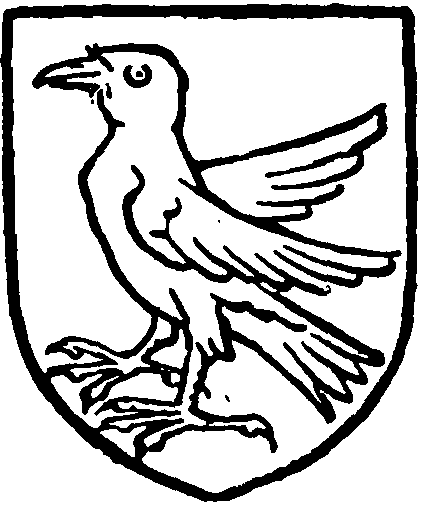
Corbet. Or a raven sable.
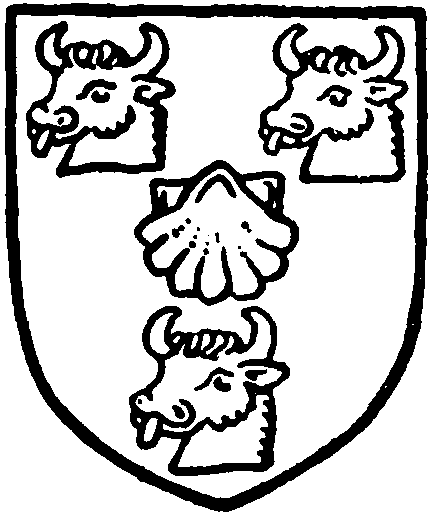
Hayter, Lord Haversham. Azure a scallop between three bulls' heads or cut off at the neck.
As has been said, the entire holding of Linslade did not pass to Maud de Mowbray at the partition between the heiresses in 1265. The second sister, Beatrice, married first Thomas Fitz Otho, and secondly William de Monchesney. (fn. 66) In 1284–6 the latter's name appears as one of the joint holders of the vill, (fn. 67) and at his death he held a capital messuage and about 72 acres of land here. (fn. 68) This portion then passed to Maud wife of John de Botetourt and daughter of Beatrice by her first husband, being her only surviving child. (fn. 69) John and Maud granted land here to William Rous, (fn. 70) and his widow held it in 1346. (fn. 71) John de Botetourt held the remainder of this share in 1302 and 1316 as half a knight's fee, (fn. 72) but by 1346 it had passed to John de Patishull, (fn. 73) a descendant of the third sister. This third heiress, Ela, married Sir Baldwin Wake. (fn. 74) She had three daughters and co-heirs, of whom the eldest, Ida, married John de Steingrave, who held part of Linslade in 1284–6. (fn. 75) Their daughter and heir Isabel married first Simon de Patishull, and secondly Walter de Teye, (fn. 76) and held her share with her second husband as early as 1297. (fn. 77) At the death of Walter about the year 1324 his stepson John de Patishull, kt., was declared his heir. (fn. 78) In 1346 land formerly held here by Walter de Teye was in the possession of Thomas de Stodleye (fn. 79); but this was probably not the entire holding, as in 1360 land in Linslade, extended at 68s. annually, became the property of Thomas Wake of Blisworth and Alice his wife, a sister and co-heir of William de Patishull, kt., (fn. 80) son of John. (fn. 81) In 1425 Maud, widow of Thomas Wake, kt., probably the son of Thomas and Alice, died seised of this land, her heir being her son Thomas. (fn. 82)
The second daughter of Ela and Baldwin, Elizabeth, married John de Hoobury, (fn. 83) who held part of Linslade in 1284–6. (fn. 84) At Elizabeth's death without issue in 1315 her heirs were her sisters' grandsons, John de Patishull, kt., and John Pigot. (fn. 85) The third daughter, Joan, married first Michael Pigot, (fn. 86) with whom she held in 1278. (fn. 87) Her second husband, Ralph Paynel, (fn. 88) held his wife's land in Linslade in 1284–6 (fn. 89) and in 1302, (fn. 90) but this holding passed before 1346 to Thomas de Stodleye, (fn. 91) and there is no further trace of it to be found.
A capital messuage is noted in the partition of estates made after the death of John de Beauchamp in 1265, (fn. 92) and was included in the lands of William de Monchesney in 1286. (fn. 93) In 1376, however, it was found that there were no buildings at all on the manor. (fn. 94) In 1251 William de Beauchamp, jun., received a grant of free warren in his demesne lands of Linslade, of a weekly market to be held there on Thursdays and of a yearly fair on the vigil and feast of the Nativity of St. Mary (8 September) and on the six days following. (fn. 95) Neither market nor fair is any longer held. A mill was included among the appurtenances of the manor in 1086, and was valued at 20s. (fn. 96) Lawsuits concerning trespass in the fisheries of Linslade occurred in the 13th century. (fn. 97)
Towards the close of the 15th century record is found of a second manor of Linslade. It was held of the Abbot of Missenden, and Sir Ralph Josselyn, kt., Mayor of London, (fn. 98) died seised of it in 1478, his heir being his nephew George. (fn. 99) His widow Elizabeth married Sir Robert Clifford, kt., as her second husband. (fn. 100) These parties were sued in 1507 by William Barlee, father of Elizabeth, (fn. 101) and others, apparently trustees, who claimed that they, rather than the Cliffords, were lawfully seised of the manor. (fn. 102) By 1538, however, the 'manor of Linslade and Southcott called Joselyn's manor' was in the possession of the Corbet family, (fn. 103) and doubtless became absorbed in the main property.
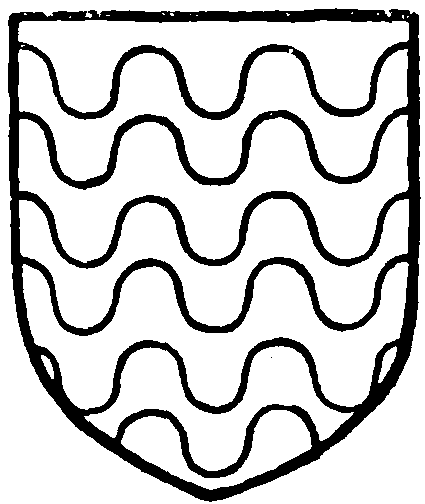
Woburn Abbey. Azure three bars wavy argent.
Land in Linslade and Southcott was held by Woburn Abbey as early as 1291, (fn. 104) and the house continued to hold property here until the Dissolution. (fn. 105) In 1553 Edward VI granted to George Wright the grange of Linslade and two water-mills and a close in this parish and that of Leighton Buzzard, all of which property had lately belonged to Woburn Abbey. (fn. 106)
The earliest mention of the hamlet of SOUTHCOTT (Suthcote, xiii cent.; Southcote, Surcott, Circott, xv–xvii cent.) occurs in 1241, when William Gernun held land here. (fn. 107) It was held as a manor, with that of Linslade, by Thomas Duke of Norfolk, who died in 1400. (fn. 108) Subsequently it descended with Linslade (q.v.), and is last mentioned as a separate manorial holding about the close of the 17th century. (fn. 109)
CHURCHES
The old church of ST. MARY THE VIRGIN consists of a chancel 23 ft. 9 in. by 12 ft., nave 45 ft. by 18 ft. 6 in., west tower 10 ft. 6 in. by 10 ft., and a south porch.
There was a 12th-century church on the site, consisting of a chancel and nave. The chancel, which was largely rebuilt in the 15th century, has its axis inclined to the northward of that of the nave, and some of the old material has been re-used. The west tower and south porch were added at the same time. There was a complete restoration in 1897. The walls are of a reddish sandstone rubble, the dressings being all much restored or modern. The roof of the chancel is tiled, and that of the nave covered with lead.
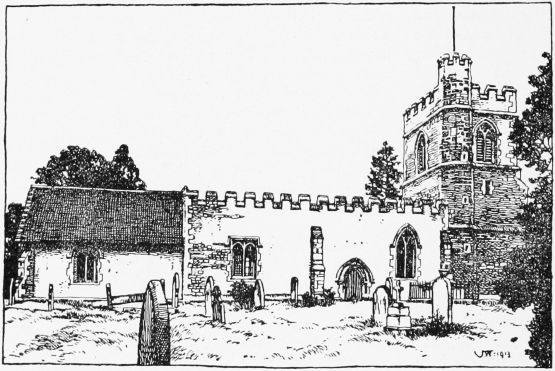
Linslade Church from the North-east
All the detail of the chancel is of 15th-century date. The east window is of three cinquefoiled lights in a four-centred head; to the north of it is a large moulded stone bracket. In the north wall is a window of two cinquefoiled lights in a four-centred head, having an external label with stops carved as angels holding shields, and in the south wall is a similar window, much restored externally, the internal sill of which is lowered to form a sedile. At the west end of the south wall is a restored two-light transomed low-side window which retains the hooks and staple for the original shutter. This window and the modern south doorway have original rear arches. The piscina has a four-centred head, and east of it is a small rectangular recess, while in the west wall, south of the chancel arch, is a semicircular-headed recess containing a seat. The semicircular chancel arch, which is of 12th-century date and of a single square order, retains traces of mediaeval colouring. The square jambs are plastered, and the abaci are either modern or have been recut.
In the east wall of the nave, north of the chancel arch, is the head of a 15th-century niche or recess, crudely moulded and having sunk spandrels. In the north wall are two modern two-light windows, the western having original 14th-century inner jambs and rear arch. Between the windows, and visible only externally, is a blocked doorway of the same date with an arch of two moulded orders, the outer continuous, the inner dying into chamfered jambs. Above the doorway are remains of an earlier label reset. In the south wall are two restored windows, with cinquefoiled lights and segmental rear arches, and between them a 15th-century doorway with a two-centred head and jambs continuously moulded.
The 15th-century west tower is of three stages, and has an embattled parapet. There are diagonal buttresses at the western angles and a semi-octagonal stair-turret at the north-east angle carried above the roof of the tower. The west window has three lights with tracery, partly renewed. The tower arch is two-centred and of two orders, the outer continuous and the inner springing from semioctagonal responds with moulded capitals and bases. The four windows of the bellchamber, each of two lights with tracery, the two loops of the ringing chamber, and the three loops of the stair-turret, are all either modern or entirely restored, with the exception of the lowest of the loops of the stair-turret. The doorway to the stairturret is original and has its old door.
The south porch has a much restored 15th-century entrance arch of two continuous orders, the inner moulded and two-centred and the outer hollow chamfered and rectangular, with sunk quatrefoils in the spandrels. Internally there is a 15th-century stoup with a four-centred head; its bowl is broken.
The roof of the chancel has large moulded and cambered tie-beams and moulded principal rafters, purlins and wall-plates, the latter being also embattled.
On the north wall of the chancel is a brass with an undated black-letter inscription in Latin to Agnes Atoun (or Atome), mother of John Atoun, Prior of Chicksand (c. 1493); on the west wall of the nave is another brass with the figures of a civilian and (presumably) three wives in pedimental head-dress, and a small plate with the figures of three boys and three girls.
On the north wall of the chancel is a wooden tablet, with an achievement of arms, erected in 1810 by Sir Andrew Corbet, bart., to Sir Andrew Corbet of Moreton Corbet (co. Salop) and of Linslade, who died in 1637, and to other members of the family down to 1796. The chancel screen has been much restored, but two bays on either side are of 15th-century date; the upper panels have pierced tracery and the lower sunk tracery.
The 13th-century font has a circular bowl with carved ornament of foliage and animals round the top, and an octagonal stem with a moulded base.
There is an old bell-framing dated 1700 for five bells which have been removed to the church of St. Barnabas, and were replaced by a single bell by John Warner & Sons of London, 1869.
The church of ST. BARNABAS was built in 1849, and consists of a chancel, nave, west tower, north porch and south aisle and chapel. The tower contains eight bells: the treble and tenor were given in 1904, the second is by John Warner & Sons, 1869, while the third, fourth, fifth, sixth and seventh, by William Chapman of London, 1781, were brought from the old church of St. Mary in 1869.
The plate is modern.
The registers date from 1690.
ADVOWSON
Simon de Beauchamp before 1198–9 gave the church to the priory of Chicksands (fn. 110) which had been founded by Payn de Beauchamp and Roais, his parents. The grant was confirmed by Simon's son William. (fn. 111) In 1291, (fn. 112) and again in 1535, when it was still held by the priory, the benefice was valued at £8. (fn. 113) A vicarage was ordained before 1286. (fn. 114) There were, however, no institutions to it after 1500, about which date the vicarial and rectorial tithes were apparently both taken by the prior. (fn. 115) After that time the church was served by stipendiary curates presented by the lords of the manor, who were the lay rectors, (fn. 116) until, in 1863–4, the patronage passed to the Bishops of Oxford, by whom it is still held. The living became a vicarage in 1868–9. The benefice has been frequently augmented by Queen Anne's Bounty (fn. 117) and by the Ecclesiastical Commissioners. (fn. 118) In 1872 the latter body granted £200 in addition to £200 already given for the purchase of certain land as an addition to the glebe of the vicarage and for improvements to the parsonage-house. (fn. 119)
After the Dissolution the rectory was granted in fee to Anne Corbet, widow (fn. 120); it afterwards passed to her male heirs and descendants with the manor (q.v.). When Sir Vincent Corbet compounded for his estates in 1646–50 his fine of £2,822 was ordered to be reduced to £2,022 if he would settle £80 per annum for the maintenance of the ministry in Linslade Church. (fn. 121)
CHARITIES
Sermon Charity. There was a rent-charge of 12s. out of lands in Leighton Buzzard (Beds.), formerly paid to the vicar for preaching a sermon on Easter Monday.
In 1826 Sir Andrew Corbet gave £25, now represented by £24 15s. 11d. consols, the income to be distributed annually in bread. The dividends, amounting to 12s. 4d., are divided equally among five poor widows.
In 1837 Mary Peacock, by her will proved at Canterbury 8 June, bequeathed £100 consols, the income, subject to keeping certain tombstones in the churchyard in repair, to be distributed annually in half-crowns among aged widows, the sick and most necessitous families. The dividends, amounting to £2 10s., are duly applied.
In 1880 Edward Lawford, M.D., by a memorandum dated 14 August, gave a sum of £52 18s. 4d. consols, the income, amounting to £1 6s. 4d., to be applied in distribution of blankets in the first week of November yearly. Six blankets are usually given.
In 1891 James Hadley, by his will proved at London 26 February, bequeathed £100, income to be applied in the distribution of bread to poor widows on St. Thomas's Day. The legacy was augmented by a gift of £50 by Mrs. Elizabeth Hadley. The two sums were invested in £155 0s. 9d. consols, producing £3 17s. 4d. yearly, which is applied in supplying tickets for groceries for poor widows.
In 1893 Miss Catharine Lawford, by her will, proved with a codicil at London 18 September, bequeathed £90, now represented by £9 15s., the income, amounting to £2 5s. 4d., to be distributed in half-crowns to deserving poor on All Saints' Day.
